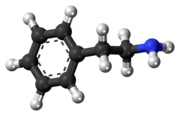Phenethylamine
 |
|
 |
|
| Clinical data | |
|---|---|
| Pronunciation | /fɛnˈɛθələmiːn/ |
| Dependence liability |
Psychological: low–moderate Physical: none |
| Addiction liability |
Low (without an MAO-B inhibitor) Moderate (with an MAO-B inhibitor) |
| Routes of administration |
Oral |
| ATC code | none |
| Legal status | |
| Legal status |
|
| Pharmacokinetic data | |
| Metabolism | Primarily: MAO-B and ALDH Other enzymes: MAO-A, SSAOs, PNMT, AANAT, FMO3, and others |
| Biological half-life | Exogenous: 5–10 minutes Endogenous: ~30 seconds |
| Identifiers | |
|
|
| Synonyms | 1-amino-2-phenylethane |
| CAS Number |
64-04-0 |
| PubChem (CID) | 1001 |
| IUPHAR/BPS | 2144 |
| DrugBank |
DB04325 |
| ChemSpider |
13856352 |
| UNII |
327C7L2BXQ |
| KEGG |
C05332 |
| ChEBI |
CHEBI:18397 |
| ChEMBL |
CHEMBL610 |
| NIAID ChemDB | 018561 |
| ECHA InfoCard | 100.000.523 |
| Chemical and physical data | |
| Formula | C8H11N |
| Molar mass | 121.18 g/mol |
| 3D model (Jmol) | Interactive image |
| Density | 0.9640 g/cm3 |
| Melting point | −60 °C (−76 °F) |
| Boiling point | 195 °C (383 °F) |
|
|
|
|
Phenethylamine (PEA), also known as β-phenylethylamine (β-PEA) and 2-phenylethan-1-amine, is an organic compound and a natural monoamine alkaloid, a trace amine, and also the name of a class of chemicals with many members that are well known for their psychoactive and stimulant effects.
Phenylethylamine functions as a monoaminergic neuromodulator and, to a lesser extent, a neurotransmitter in the human central nervous system. It is biosynthesized from the amino acid L-phenylalanine by enzymatic decarboxylation via the enzyme aromatic L-amino acid decarboxylase. In addition to its presence in mammals, phenethylamine is found in many other organisms and foods, such as chocolate, especially after microbial fermentation. It is sold as a dietary supplement for purported mood and weight loss-related therapeutic benefits; however, orally ingested phenethylamine is primarily metabolized in the small intestine by monoamine oxidase B (MAO-B) and then aldehyde dehydrogenase (ALDH), which convert it to phenylacetic acid. This prevents significant concentrations from reaching the brain when taken in low doses.
...
Wikipedia
